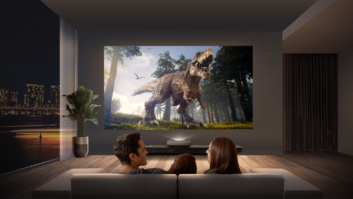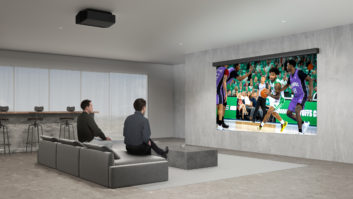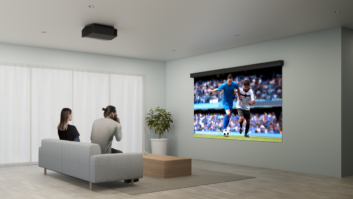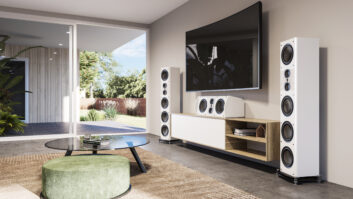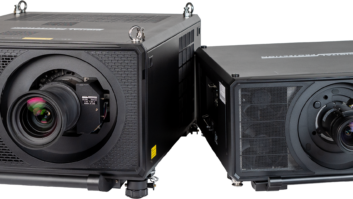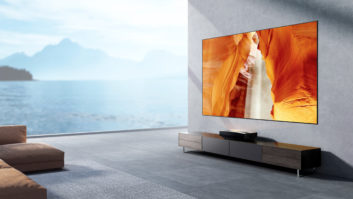
Edge-blended, multi-projector screen presentations, such as this from Sony, benefit greatly from the constant output over time of laser projectors. Over the years, the InfoComm trade show has become a key place for those in the commercial, educational, enterprise, and “house of worship” markets to see the latest and greatest in video and displays. There are more than a few residential integration types that haunt the aisles of this annual convention for content creation, distribution, and display products that they don’t see at the likes of CES, IFA, or CEDIA EXPO. This year’s show didn’t disappoint, with its displays featuring the latest in projection technology and 4K.
Anyone questioning the value of 4K/UHD was immediately stripped of that uncertainty the moment they walked into the LVCC’s Central Hall. Crestron’s booth, one of the largest at the show, made it very plain that 4K was real, and they were staking out their piece of the action with a wide range of products that, save for cameras, displays, and storage covered everything you needed to get 4K from here to there. Expect to see much of this replicated in September at CEDIA EXPO in Denver as Crestron shows its scalars, distribution gear, switching, and more. This is a clear case of the need for 4K in one market helping to birth products across many.

Leyard’s 110-inch display looks like an old CRT or DLP rear screen, but it actually uses the same type of LED array as scoreboard displays. In many minds, however, the question still remains: “What’s the big deal? Unless you sit really close to the screen, or conversely, sit at normal distances and provide a really, really big screen, no one can tell the difference.” To some extent that’s true, but particularly at the Display Summit conference that preceded InfoComm, the presentations continued the theme of not just “more pixels” (e.g. 4K versus 2K), but “better pixels” and “faster pixels.” The former will be the arrival of displays and projectors capable of displaying the wider color space of ITU Rec. 2020, with High Dynamic Range (HDR), more bits to describe the color (10 or 12 bits rather than the current eight), and more precise color sampling (hopefully 4:4:4 rather than 4:2:0 or 4:2:2). The latter, which is particularly important for sports, will be the use of 60fps or higher frame rates. In spite of that, keep in mind that according to a comment made by Phil Squyres, SVP of technical operations for Sony Pictures Television, all of the more than 100 TV episodes that Sony has produced in 4K were shot at the old-fashioned “fractional” rate of 23.98fps.
The fact remains that, for now, we’re still mostly at the “more,” rather than “better and faster” pixel stage of things. With proper scaling, 4K still remains a viable technology and at the end of the day, forces outside of the consumer world will push the volumes to a point where most displays above “bargain” price points will be 4K sooner than later. The volume of 4K sets being produced for the China market is one part of that, but things in evidence at InfoComm contribute to that, as well.
Think about it: “close in” viewing is exactly what the growing world of digital signage is all about. This is not just for the menu boards at a quick-serve restaurant, but also for shop windows where the viewing distance is close and the goods expensive enough that image quality is critical. Those seemingly opposite ends of the digital signage market have become a key segment for the brands displaying at InfoComm, and 4K was all over the place.

Ricoh’s short-throw projector was one of many products at InfoComm that showed the benefits of that configuration. Even at the “large-venue” part of the market, where projection and LED boards dominate, 4K was everywhere at InfoComm. Do you have a client that wants an ultra-bright, large display that is suitable for outdoor use just like a stadium scoreboard? LED arrays in 4K can fit that bill, and they are a growing category you should keep in your knowledge base portfolio, particularly if you also do signage or light commercial work. One vendor at InfoComm even had indoor LED array displays in the same sort of cabinet configuration we used to see for rear-screen projectors, but in sizes at and over 110 inches. It’s not something you’ll use everywhere, but they are an option.
Laser Projector Developments
If for nothing else, InfoComm 2014 will be marked as the true coming out party for laser-based projectors. Using laser-based light engines rather than lamp- or LED-illuminated systems, the goal of a high light output projector that can run up to 20,000 hours before replacement and show little, if any degradation over the life of the light engine, was met by products from numerous brands.
There were a number of different technology approaches used, and the details are something we’ll address in a future article. At the top level, however, when explaining laser projection to potential clients, you should remind them that these products use the lasers to excite a phosphor color wheel, with perhaps one blue laser showing through directly to the imaging device. The normal consumer notion would be to relate the use of lasers to the higher powered devices as they see at concerts or clubs, with the potential for retinal damage if you look at the laser. While I never recommend looking into the lens of any projector due to the danger of eye damage, these are not “raster scan” lasers, but rather direct the light to an LCD, LCoS, or DLP panel. Thus, no “direct-to-the-lens” laser light, but instead, a new take on where the light comes from.

When the available space, light output, and resolution requirements are as big as the budget, this 35,000 lumen, 4K projector from Christie might fill the bill. By using the lasers and phosphor wheels as the light engine, you don’t have a lamp’s “time to half life” figure to worry about. Given that all lamps age at their own rate, different from one another, lasers mean that there is no longer the need to constantly go back to a venue to re-calibrate the units in a multi-projector installation so that the color across an edge-blended screen is uniform from one side/projector to another. While more than one projector in a room is a rarity in residential applications, the drift and light output diminution over time can be problematic as it impacts color reproduction.
That leads us to one of the key benefits of laser-based unit that you need to communicate. Not only is there the significant savings over time from the elimination of bulb changes for what can be up to seven years of use, depending on daily viewing time, but there will no longer be the need to have periodic service calls to recalibrate the unit. Yes, perhaps a bit less revenue for you but a way to justify the higher cost. You’ll make up some of the profit from missing the service calls from increased dollar margin on the projector, and then there is the value of a client that won’t have to be annoyed at color shift over time.

You wouldn’t use this sort of “see-through” LED display in a home theater, but for commercial or decorative applications, the possibilities are interesting. Note the rear of an LED array in the upper right corner showing how this sort of display is made up of multiple blocks.

Crestron’s massive and prominent InfoComm booth left no doubts as to their commitment to 4K. In terms of form factor, the laser projectors shown at InfoComm were what you would expect from a show with a non-residential focus. They ranged in price and size from the form factors of conventional “installation projectors” to the huge mega-lumen units that are the size of a jet ski. The latter units aside, another advantage of laser projectors is that they do not need to be “flat mounted,” giving additional installation flexibility that can make the price premium more than worth it. Panasonic showed this off at InfoComm as it did at NAB, with one of their laser units mounted on a rig that constantly spun it from vertical to horizontal with no ill effects.
One more benefit, particularly for high-end theater systems, is that the high light output of laser projectors makes it possible to have the equivalent of six, rather than three, imager engine channels. This makes it possible to do high light output 3D with full HD and beyond per eye with one projector. Try that with a lamp-based system.

Although it is a consumer set and was somewhat out of place at InfoComm, LG’s 105-inch UHD model is one of the few sets that really takes advantage of a curved screen. Depending on the specifics of a particular installation, if the price fits, the value is there. These are no longer science projects; they are real.
Show-Throw Projector Opportunities
Short-throw projectors have been an emerging trend in the past few years at InfoComm. This technology can be useful in classroom retrofit situations where a conventional ceiling mount is impractical or just too labor-cost intensive. Here, laser was not only seen, but in a form that presages something we also expect to see at CEDIA EXPO, where 4K, laser projectors, and large screen will come together.
In his CES keynote, Sony’s Kaz Hirai showed a widely reported on-screen image of a 147-inch, short-throw, 4K laser projector with hints that it would be on the market before year-end. That exact unit wasn’t at InfoComm, but its commercial cousin was. Seen there in matte black rather than elegant white, and without the side speakers Sony will likely offer with the consumer version, this model will give you a way to install a large screen that allows the high resolution of 4K to make an impact at normal seating distances. Pricing is not yet established, but we can assure you it will be less than that of a comparably sized 4K flat-panel–if you can find one. To sweeten the pot, the commercial version is also designed for on-wall, short-throw mounting, an option that may make sense in many rooms where the large screen size needed to show the benefit of 4K might not otherwise be possible.

LED displays as you might see in a stadium, as seen from the front and rear. Yes, there were other 4K related products and concepts at this year’s InfoComm, but it was definitely the displays that made news. Those that were there: laser-driven projectors, 4K displays, thin-mullion flat-panels that will work as well in a home sports bar as they do in the real thing, large venue/high-brightness LED array displays and sign boards among them. And, as always, those that were not there: OLED and curved screens prominent in that category, although LG did show a 105- inch curved LCD, clearly aimed at the consumer market, which had knock-out image quality.
The ability to take a step back from the consumer market to see what the commercial side of the world thinks of 4K and displays is always enlightening. Time will tell if and how what we saw at InfoComm will filter down to true consumer products. But even if they don’t, there are three key takeaways. First, all the evidence from products, seminars, and discussions at InfoComm points to 4K/UHD as something you can’t just push off with an “…it’s just another 3D and it won’t last…” Second, laser-based projectors may take a while to supplant bulb and LED-driven models, but they, too, are here to stay. Yes, some things such as “speckle” and pricing are still to be dealt with for broader application but in an increasing number of situations they may be just what you need. They are officially out of the “George Jetson/Science Project” world and are clearly a reality. Finally, when you have a display or installation product need that can’t be properly solved in the consumer/ residential market, you might find the solution in another part of the broader world of AV solutions. Take the blinders off, and you may be surprised as to what you find.
Michael Heiss ([email protected]) is a CEDIA Fellow and contributing editor to Residential Systems, based in Sherman Oaks, CA.

